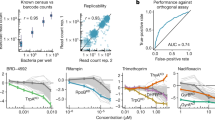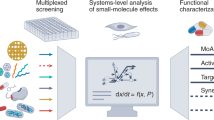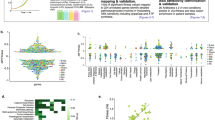Abstract
The utility of antibiotics has largely been based on their therapeutic application. However, in addition to clinical use, antibiotics have served as vital agents in probing bacterial complexity. Although not principally regarded as tools for dissecting bacterial genetics and biochemistry, antibiotics have nonetheless proved indispensable to understanding such essential functions as cell-wall biogenesis, DNA biosynthesis and the translation process. Herein we provide an overarching account of recent and landmark instances in which antibiotics have yielded critical information regarding many bacterial processes. We also elaborate on the importance of antibiotics and new chemical probes to the comprehension of genetic networks in the future. Given that antibiotics were among the first small molecules used to methodically perturb and understand biological systems, the past, present and future of antibiotics as probes of bacterial complexity offer some illustrative lessons for the broader field of chemical biology.
This is a preview of subscription content, access via your institution
Access options
Subscribe to this journal
Receive 12 print issues and online access
$259.00 per year
only $21.58 per issue
Buy this article
- Purchase on Springer Link
- Instant access to full article PDF
Prices may be subject to local taxes which are calculated during checkout






Similar content being viewed by others
References
Parker, R.F. & Luse, S. The action of penicillin on Staphylococcus: further observations on the effect of a short exposure. J. Bacteriol. 56, 75–81 (1948).
Park, J.T. & Johnson, M.J. Accumulation of labile phosphate in Staphylococcus aureus grown in the presence of penicillin. J. Biol. Chem. 179, 585–592 (1949).
Park, J.T. Uridine-5′-pyrophosphate derivatives. III. Amino acid-containing derivatives. J. Biol. Chem. 194, 897–904 (1952).
Park, J.T. Uridine-5′-pyrophosphate derivatives. II. A structure common to three derivatives. J. Biol. Chem. 194, 885–895 (1952).
Park, J.T. Uridine-5′-pyrophosphate derivatives. II. Isolation from Staphylococcus aureus. J. Biol. Chem. 194, 877–884 (1952).
Park, J.T. & Strominger, J.L. Mode of action of penicillin. Science 125, 99–101 (1957). In this landmark paper, the authors identified the mode of action of penicillin, and from these studies hypothesized the chemical constituents of the bacterial cell wall.
Nguyen-Distèche, M. et al. Sensitivity to ampicillin and cephalothin of enzymes involved in wall peptide crosslinking in Escherichia coli K12, strain 44. Eur. J. Biochem. 41, 457–463 (1974).
Spratt, B.G. & Pardee, A.B. Penicillin-binding proteins and cell shape in E. coli. Nature 254, 516–517 (1975).
Strominger, J.L., Willoughby, E., Kamiryo, T., Blumberg, P.M. & Yocum, R.R. Penicillin-sensitive enzymes and penicillin-binding components in bacterial cells. Ann. NY Acad. Sci. 235, 210–224 (1974).
Suginaka, H., Blumberg, P.M. & Strominger, J.L. Multiple penicillin-binding components in Bacillus subtilis, Bacillus cereus, Staphylococcus aureus, and Escherichia coli. J. Biol. Chem. 247, 5279–5288 (1972).
Spratt, B.G. Distinct penicillin binding proteins involved in the division, elongation, and shape of Escherichia coli K12. Proc. Natl. Acad. Sci. USA 72, 2999–3003 (1975).
van den Ent, F., Johnson, C.M., Persons, L., de Boer, P. & Lowe, J. Bacterial actin MreB assembles in complex with cell shape protein RodZ. EMBO J. 29, 1081–1090 (2010).
Paradis-Bleau, C. et al. Lipoprotein cofactors located in the outer membrane activate bacterial cell wall polymerases. Cell 143, 1110–1120 (2010).
Typas, A. et al. Regulation of peptidoglycan synthesis by outer-membrane proteins. Cell 143, 1097–1109 (2010).
Gellert, M., Mizuuchi, K., O'Dea, M.H. & Nash, H.A. DNA gyrase: an enzyme that introduces superhelical turns into DNA. Proc. Natl. Acad. Sci. USA 73, 3872–3876 (1976).
Luttinger, A. The twisted 'life' of DNA in the cell: bacterial topoisomerases. Mol. Microbiol. 15, 601–606 (1995).
Gellert, M., O'Dea, M.H., Itoh, T. & Tomizawa, J. Novobiocin and coumermycin inhibit DNA supercoiling catalyzed by DNA gyrase. Proc. Natl. Acad. Sci. USA 73, 4474–4478 (1976).
Gellert, M., Mizuuchi, K., O'Dea, M.H., Itoh, T. & Tomizawa, J.I. Nalidixic acid resistance: a second genetic character involved in DNA gyrase activity. Proc. Natl. Acad. Sci. USA 74, 4772–4776 (1977). Using aminocoumarins and quinolone antibiotics as probes, this study revealed a second function of DNA gyrase.
Higgins, N.P., Peebles, C.L., Sugino, A. & Cozzarelli, N.R. Purification of subunits of Escherichia coli DNA gyrase and reconstitution of enzymatic activity. Proc. Natl. Acad. Sci. USA 75, 1773–1777 (1978).
Piton, J. et al. Structural insights into the quinolone resistance mechanism of Mycobacterium tuberculosis DNA gyrase. PLoS ONE 5, e12245 (2010).
Bax, B.D. et al. Type IIA topoisomerase inhibition by a new class of antibacterial agents. Nature 466, 935–940 (2010).
Blanchard, S.C., Cooperman, B.S. & Wilson, D.N. Probing translation with small-molecule inhibitors. Chem. Biol. 17, 633–645 (2010).
Yarmolinsky, M.B. & Haba, G.L. Inhibition by puromycin of amino acid incorporation into protein. Proc. Natl. Acad. Sci. USA 45, 1721–1729 (1959).
Nathans, D. Puromycin Inhibition of Protein Synthesis: Incorporation of Puromycin into Peptide Chains. Proc. Natl. Acad. Sci. USA 51, 585–592 (1964).
Gao, H. et al. RF3 induces ribosomal conformational changes responsible for dissociation of class I release factors. Cell 129, 929–941 (2007).
Zavialov, A.V., Buckingham, R.H. & Ehrenberg, M. A posttermination ribosomal complex is the guanine nucleotide exchange factor for peptide release factor RF3. Cell 107, 115–124 (2001).
Sternberg, S.H., Fei, J., Prywes, N., McGrath, K.A. & Gonzalez, R.L. Jr. Translation factors direct intrinsic ribosome dynamics during translation termination and ribosome recycling. Nat. Struct. Mol. Biol. 16, 861–868 (2009).
Pavlov, M.Y., Antoun, A., Lovmar, M. & Ehrenberg, M. Complementary roles of initiation factor 1 and ribosome recycling factor in 70S ribosome splitting. EMBO J. 27, 1706–1717 (2008).
Lockwood, A.H., Chakraborty, P.R. & Maitra, U. A complex between initiation factor IF2, guanosine triphosphate, and fMet-tRNA: an intermediate in initiation complex formation. Proc. Natl. Acad. Sci. USA 68, 3122–3126 (1971).
Traut, R.R. & Monro, R.E. The puromycin reaction and its relation to protein synthesis. J. Mol. Biol. 10, 63–72 (1964).This study was among the first to use puromycin as a tool to understand protein synthesis and to probe the nature of the peptidyl transfer process.
Monro, R.E. Catalysis of peptide bond formation by 50 S ribosomal subunits from Escherichia coli. J. Mol. Biol. 26, 147–151 (1967).
Chadani, Y. et al. Ribosome rescue by Escherichia coli ArfA (YhdL) in the absence of trans-translation system. Mol. Microbiol. 78, 796–808 (2010).
Jiang, L. et al. Recycling of aborted ribosomal 50S subunit-nascent chain-tRNA complexes by the heat shock protein Hsp15. J. Mol. Biol. 386, 1357–1367 (2009).
Garcia-Ortega, L., Stephen, J. & Joseph, S. Precise alignment of peptidyl tRNA by the decoding center is essential for EF-G–dependent translocation. Mol. Cell 32, 292–299 (2008).
Shinagawa, H. SOS response as an adaptive response to DNA damage in prokaryotes. EXS 77, 221–235 (1996).
Miller, C. et al. SOS response induction by β-lactams and bacterial defense against antibiotic lethality. Science 305, 1629–1631 (2004).
Miller, C., Ingmer, H., Thomsen, L.E., Skarstad, K. & Cohen, S.N. DpiA binding to the replication origin of Escherichia coli plasmids and chromosomes destabilizes plasmid inheritance and induces the bacterial SOS response. J. Bacteriol. 185, 6025–6031 (2003).
Kohanski, M.A., Dwyer, D.J., Hayete, B., Lawrence, C.A. & Collins, J.J. A common mechanism of cellular death induced by bactericidal antibiotics. Cell 130, 797–810 (2007).
Dwyer, D.J., Kohanski, M.A., Hayete, B. & Collins, J.J. Gyrase inhibitors induce an oxidative damage cellular death pathway in Escherichia coli. Mol. Syst. Biol. 3, 91 (2007).
Kohanski, M.A., Dwyer, D.J., Wierzbowski, J., Cottarel, G. & Collins, J.J. Mistranslation of membrane proteins and two-component system activation trigger antibiotic-mediated cell death. Cell 135, 679–690 (2008).In this report, the authors elaborate on the their previous landmark findings that showed that bactericidal antibiotics lead to cell death via oxidative damage, here using antibiotics to elucidate the cellular events that occur between the time of antibiotic application and oxidative-stress-induced death.
Lee, H.H., Molla, M.N., Cantor, C.R. & Collins, J.J. Bacterial charity work leads to population-wide resistance. Nature 467, 82–85 (2010).
van Stelten, J., Silva, F., Belin, D. & Silhavy, T.J. Effects of antibiotics and a proto-oncogene homolog on destruction of protein translocator SecY. Science 325, 753–756 (2009).This work used antibiotics to explore the mechanistic details of protein translocation, which in turn provided insight regarding the origin of toxicity that results in cells struggling during protein secretion.
Rapoport, T.A. Protein translocation across the eukaryotic endoplasmic reticulum and bacterial plasma membranes. Nature 450, 663–669 (2007).
Bowers, C.W., Lau, F. & Silhavy, T.J. Secretion of LamB-LacZ by the signal recognition particle pathway of Escherichia coli. J. Bacteriol. 185, 5697–5705 (2003).
Hegde, R.S. & Bernstein, H.D. The surprising complexity of signal sequences. Trends Biochem. Sci. 31, 563–571 (2006).
Koteva, K. et al. A vancomycin photoprobe identifies the histidine kinase VanSsc as a vancomycin receptor. Nat. Chem. Biol. 6, 327–329 (2010).Based on the use of a vancomycin photoaffinity probe, this report answered the long-standing question as to the precise mechanism of vancomycin resistance.
Tomasz, A. The mechanism of the irreversible antimicrobial effects of penicillins: how the β-lactam antibiotics kill and lyse bacteria. Annu. Rev. Microbiol. 33, 113–137 (1979).
Goehring, N.W. & Beckwith, J. Diverse paths to midcell: assembly of the bacterial cell division machinery. Curr. Biol. 15, R514–R526 (2005).
García del Portillo, F. & de Pedro, M.A. Differential effect of mutational impairment of penicillin-binding proteins 1A and 1B on Escherichia coli strains harboring thermosensitive mutations in the cell division genes ftsA, ftsQ, ftsZ, and pbpB. J. Bacteriol. 172, 5863–5870 (1990).
Chung, H.S. et al. Rapid β-lactam–induced lysis requires successful assembly of the cell division machinery. Proc. Natl. Acad. Sci. USA 106, 21872–21877 (2009).In this work, cephalexin was employed as a chemical tool to explain the relationship between divisome assembly and cell lysis, revealing the mechanistic basis for the requirement of an intact divisome before lysis can take place.
Uehara, T., Parzych, K.R., Dinh, T. & Bernhardt, T.G. Daughter cell separation is controlled by cytokinetic ring-activated cell wall hydrolysis. EMBO J. 29, 1412–1422 (2010).
D'Elia, M.A. et al. Probing teichoic acid genetics with bioactive molecules reveals new interactions among diverse processes in bacterial cell wall biogenesis. Chem. Biol. 16, 548–556 (2009).
Schirner, K., Marles-Wright, J., Lewis, R.J. & Errington, J. Distinct and essential morphogenic functions for wall- and lipo-teichoic acids in Bacillus subtilis. EMBO J. 28, 830–842 (2009).
Collins, L.V. et al. Staphylococcus aureus strains lacking D-alanine modifications of teichoic acids are highly susceptible to human neutrophil killing and are virulence attenuated in mice. J. Infect. Dis. 186, 214–219 (2002).
Bhavsar, A.P., Beveridge, T.J. & Brown, E.D. Precise deletion of tagD and controlled depletion of its product, glycerol 3-phosphate cytidylyltransferase, leads to irregular morphology and lysis of Bacillus subtilis grown at physiological temperature. J. Bacteriol. 183, 6688–6693 (2001).
D'Elia, M.A., Millar, K.E., Beveridge, T.J. & Brown, E.D. Wall teichoic acid polymers are dispensable for cell viability in Bacillus subtilis. J. Bacteriol. 188, 8313–8316 (2006).
D'Elia, M.A. et al. Lesions in teichoic acid biosynthesis in Staphylococcus aureus lead to a lethal gain of function in the otherwise dispensable pathway. J. Bacteriol. 188, 4183–4189 (2006).
Weidenmaier, C. et al. Role of teichoic acids in Staphylococcus aureus nasal colonization, a major risk factor in nosocomial infections. Nat. Med. 10, 243–245 (2004).
Swoboda, J.G. et al. Discovery of a small molecule that blocks wall teichoic acid biosynthesis in Staphylococcus aureus. ACS Chem. Biol. 4, 875–883 (2009).
Tong, A.H. et al. Systematic genetic analysis with ordered arrays of yeast deletion mutants. Science 294, 2364–2368 (2001).
Wong, S.L. et al. Combining biological networks to predict genetic interactions. Proc. Natl. Acad. Sci. USA 101, 15682–15687 (2004).
Costanzo, M. et al. The genetic landscape of a cell. Science 327, 425–431 (2010).
Hillenmeyer, M.E. et al. The chemical genomic portrait of yeast: uncovering a phenotype for all genes. Science 320, 362–365 (2008).
Butland, G. et al. Interaction network containing conserved and essential protein complexes in Escherichia coli. Nature 433, 531–537 (2005).
Baba, T. et al. Construction of Escherichia coli K-12 in-frame, single-gene knockout mutants: the Keio collection. Mol. Syst. Biol. 2, 2006.0008 (2006).
Typas, A. et al. High-throughput, quantitative analyses of genetic interactions in E. coli. Nat. Methods 5, 781–787 (2008).
Butland, G. et al. eSGA: E. coli synthetic genetic array analysis. Nat. Methods 5, 789–795 (2008).
Tamae, C. et al. Determination of antibiotic hypersensitivity among 4,000 single-gene-knockout mutants of Escherichia coli. J. Bacteriol. 190, 5981–5988 (2008).
Brown, K.R. et al. NAViGaTOR: Network Analysis, Visualization and Graphing Toronto. Bioinformatics 25, 3327–3329 (2009).
Nichols, R.J. et al. Phenotypic landscape of a bacterial cell. Cell 144, 143–156 (2011).
Young, K. et al. Discovery of FabH/FabF inhibitors from natural products. Antimicrob. Agents Chemother. 50, 519–526 (2006).
Wang, J. et al. Platensimycin is a selective FabF inhibitor with potent antibiotic properties. Nature 441, 358–361 (2006).
Donald, R.G. et al. A Staphylococcus aureus fitness test platform for mechanism-based profiling of antibacterial compounds. Chem. Biol. 16, 826–836 (2009).
Kitagawa, M. et al. Complete set of ORF clones of Escherichia coli ASKA library (a complete set of E. coli K-12 ORF archive): unique resources for biological research. DNA Res. 12, 291–299 (2005).
Li, X. et al. Multicopy suppressors for novel antibacterial compounds reveal targets and drug efflux susceptibility. Chem. Biol. 11, 1423–1430 (2004).
Pathania, R. et al. Chemical genomics in Escherichia coli identifies an inhibitor of bacterial lipoprotein targeting. Nat. Chem. Biol. 5, 849–856 (2009).Using a genome-scale library of E. coli overexpression strains in combination with antibacterial compounds of unknown mechanism, this work led to the identification of a novel probe of lipoprotein targeting.
Yeh, P., Tschumi, A.I. & Kishony, R. Functional classification of drugs by properties of their pairwise interactions. Nat. Genet. 38, 489–494 (2006).
Farha, M.A. & Brown, E.D. Chemical probes of Escherichia coli uncovered through chemical-chemical interaction profiling with compounds of known biological activity. Chem. Biol. 17, 852–862 (2010).
Acknowledgements
E.D.B. acknowledges salary support from the Canada Research Chairs program and operating funds from the Canadian Institutes of Health Research (MOP-15496, MOP-64292 and MOP-81330) and Cystic Fibrosis Canada.
Author information
Authors and Affiliations
Corresponding author
Ethics declarations
Competing interests
The authors declare no competing financial interests.
Supplementary information
Supplementary Data
NAViGaTOR file for Figure 6 (XML 277 kb)
Rights and permissions
About this article
Cite this article
Falconer, S., Czarny, T. & Brown, E. Antibiotics as probes of biological complexity. Nat Chem Biol 7, 415–423 (2011). https://doi.org/10.1038/nchembio.590
Published:
Issue Date:
DOI: https://doi.org/10.1038/nchembio.590
This article is cited by
-
The physiology and genetics of bacterial responses to antibiotic combinations
Nature Reviews Microbiology (2022)
-
Mechanisms of drug interactions between translation-inhibiting antibiotics
Nature Communications (2020)
-
Strong increase in the autofluorescence of cells signals struggle for survival
Scientific Reports (2018)
-
Chemical modulators of ribosome biogenesis as biological probes
Nature Chemical Biology (2015)
-
Taking aim at wall teichoic acid synthesis: new biology and new leads for antibiotics
The Journal of Antibiotics (2014)



